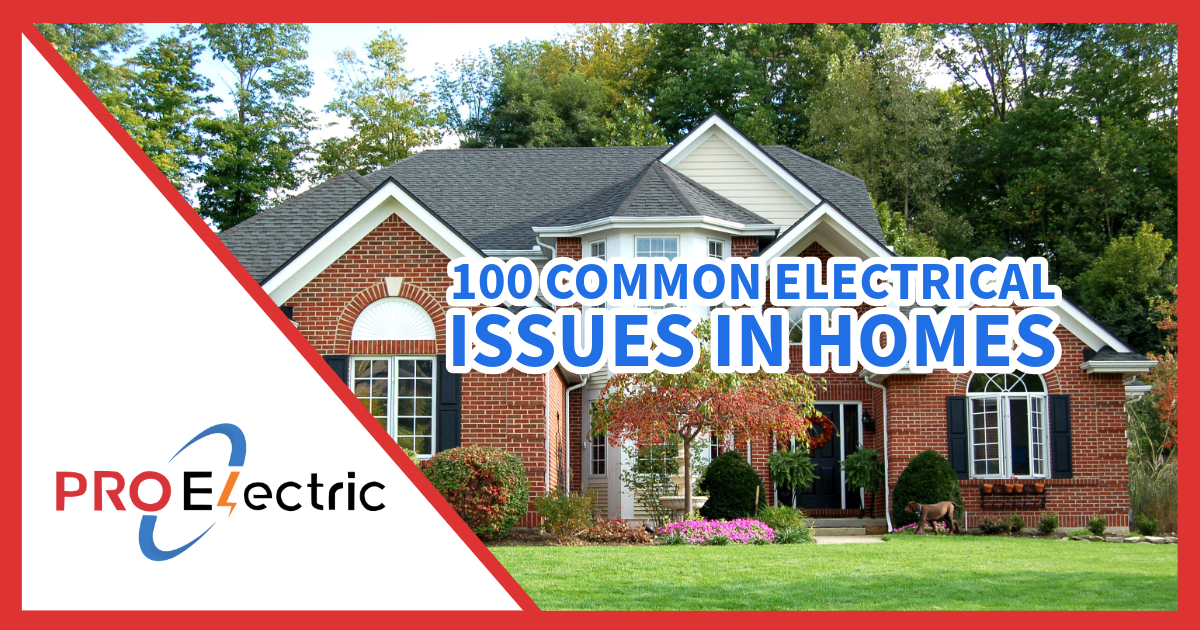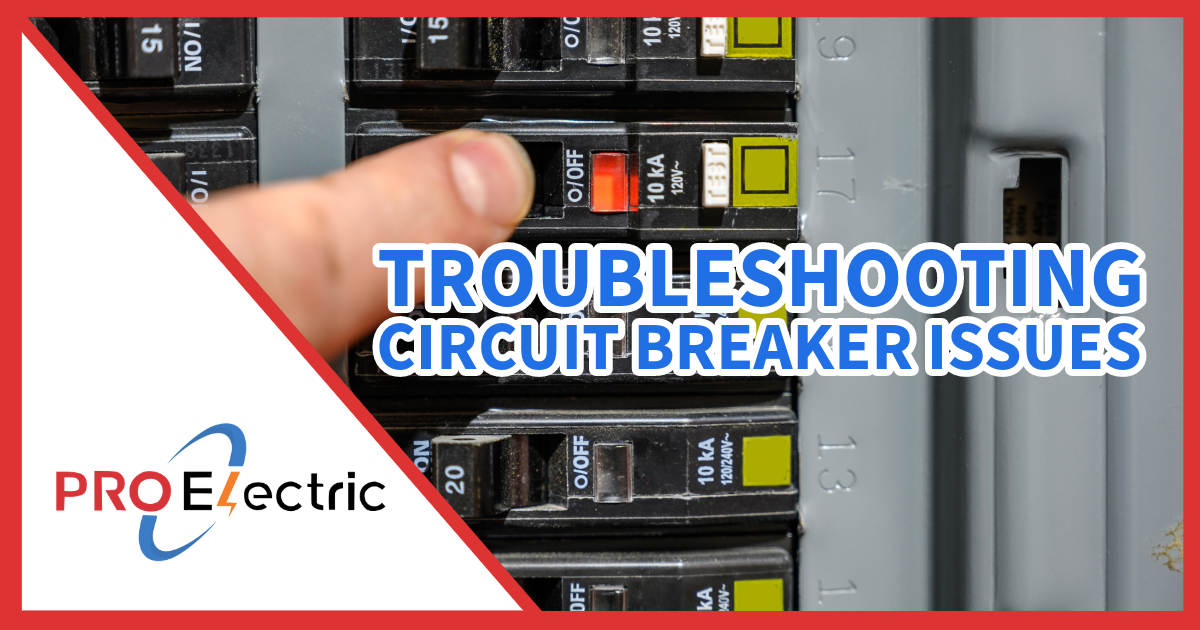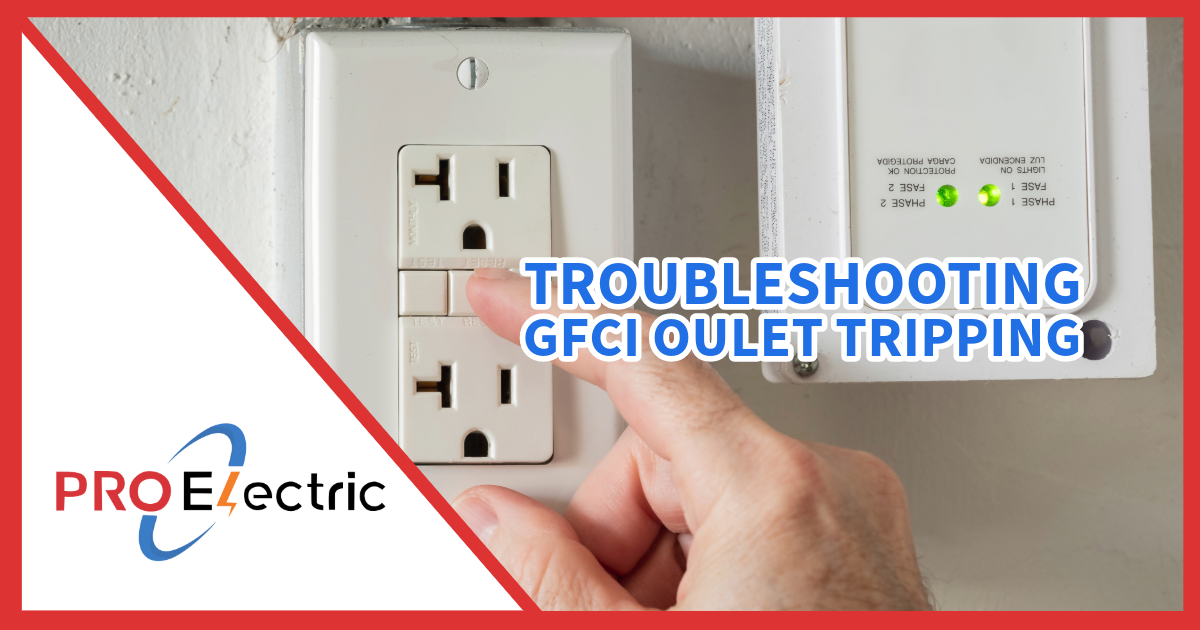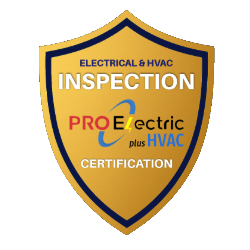100 POTENTIAL ISSUES IN ALPHABETICAL ORDERAre you confident that your home's electrical system is safe and efficient?

With so many potential issues—from outdated wiring to faulty breakers—it’s crucial to address these risks before they become hazards.
Each problem might seem minor, but they can compromise your safety and peace of mind.
Take a proactive approach: identify and fix these common electrical issues to ensure your home remains safe.
Don’t wait for a warning sign—your family’s safety is too important to leave to chance.
Absent GFCI Outlets
Do you have GFCI outlets in wet areas?
Without GFCI outlets, you risk electric shocks in bathrooms or kitchens. Install them to prevent accidents.
Aging Wiring
Is your home’s wiring over 30 years old?
Aging wiring can deteriorate and become a fire hazard. Consider upgrading to modern, safer wiring.
Arc Faults
Are you noticing frequent sparks or smells from outlets?
Arc faults can cause fires. Arc-fault circuit interrupters (AFCIs) can help prevent this danger.
Backstabbed Wires
Are wires loosely connected to outlets?
Backstabbed wires can quickly become loose, causing overheating or arcing. Rewire using screws for a secure connection.
Breaker Won’t Reset
Does your breaker keep tripping and won’t reset?
This could indicate a persistent fault in the circuit. It’s essential to diagnose and fix the underlying issue.
Burned Outlets
Do you see black marks around your outlets?
Burned outlets are a severe fire risk. Replace them immediately and investigate the cause.
Circuit Breaker Trips Frequently
Is your breaker constantly tripping?
Frequent trips usually mean an overloaded circuit. Redistribute the load or upgrade your electrical panel.
Corroded Wiring
Have you noticed green or white powder on wires?
Corrosion weakens connections and increases the risk of fire. Replace corroded wiring to ensure safety.
Damaged Electrical Cords
Are any of your appliance cords frayed or cut?
Damaged cords can expose wires, leading to shocks or fires. Replace them promptly.
Dead Outlets
Do some outlets in your home not work?
Dead outlets can indicate a wiring issue or a tripped breaker. It’s important to identify and fix the problem.
Dimmer Switch Buzzing
Does your dimmer switch make noise?
A buzzing dimmer switch may indicate an overloaded circuit or a compatibility issue with your bulbs. Upgrade or replace as needed.
Discolored Outlets
Are your outlets turning brown or yellow?
Discoloration is a sign of overheating, which can lead to fires. Replace these outlets immediately.
Electric Shocks
Do you feel a shock when you touch an appliance or switch?
Electric shocks indicate grounding issues or faulty wiring. Have an electrician inspect your system.
Electrical Panel Overheating
Is your electrical panel warm to the touch?
Overheating panels are a fire hazard. It’s essential to have this checked by a professional.
Electrical Surges
Are your appliances frequently damaged by surges?
Surges can be caused by faulty wiring or lightning. Installing a surge protector can help.
Exposed Wiring
Do you see wires without proper insulation?
Exposed wiring is dangerous and can cause shocks or fires. Ensure all wiring is properly insulated.
Faulty Appliance Wiring
Do appliances short out or spark?
Faulty wiring within appliances can be a fire risk. Have the wiring repaired or replace the appliance.
Faulty Circuit Breaker
Does your breaker trip without cause?
A faulty breaker may not protect your home as it should. Replace it to maintain safety.
Faulty Light Switches
Are your light switches unresponsive or flickering?
Faulty switches can indicate wiring problems. Replacing them can prevent further issues.
Faulty Outlets
Do some outlets feel loose or don’t hold plugs well?
Faulty outlets may not provide power or can overheat. Replace them to avoid hazards.
Faulty Smoke Detectors
Are your smoke detectors not working?
Faulty detectors may not alert you in case of fire. Regularly test and replace them as needed.
Flickering Lights
Do your lights flicker often?
Flickering lights can indicate loose wiring or an overloaded circuit. Address these issues to prevent potential hazards.
Grounding Issues
Is your home properly grounded?
Poor grounding can lead to electric shocks and equipment damage. Ensure your electrical system is grounded correctly.
Hot Ceiling Fixtures
Do your ceiling fixtures feel hot to the touch?
Hot fixtures can overheat and cause fires. Use bulbs with the correct wattage to avoid this issue.
Inadequate Circuit Capacity
Does your breaker trip when using multiple appliances?
Inadequate circuit capacity can cause overloads. Consider adding more circuits to handle the load.
Inconsistent Power
Is your power supply unreliable?
Inconsistent power can damage appliances and indicate underlying electrical issues. Have your system inspected.
Insufficient Outlets
Do you rely heavily on power strips?
Insufficient outlets can lead to overloads. Adding more outlets can distribute the load more safely.
Intermittent Power Loss
Does your power cut out occasionally?
Intermittent power loss may indicate a loose connection or faulty wiring. Have an electrician troubleshoot the issue.
Inverted Polarity
Are some of your outlets wired backward?
Inverted polarity can be dangerous, causing shocks. Have it corrected to ensure safety.
Loose Connections
Do outlets or switches move when touched?
Loose connections can cause arcing or overheating. Secure or replace them to prevent fires.
Loose Outlet Plugs
Do plugs fall out of your outlets easily?
Loose plugs can lead to poor connections and overheating. Replace the outlet to ensure a secure fit.
Miswired 3-Way Switches
Do your 3-way switches work inconsistently?
Miswiring can cause flickering or dead switches. Correct the wiring to ensure proper operation.
Mixed Wire Gauges
Are wires of different sizes connected together?
Mixing wire gauges can cause overheating. Use the correct gauge wire for each circuit.
Missing Switch Covers
Are any of your switches missing covers?
Exposed wiring in uncovered switches is a shock hazard. Install covers to protect the wiring.
No Dedicated Circuits for Major Appliances
Are your major appliances sharing circuits?
Appliances like refrigerators and ovens need dedicated circuits to prevent overloads. Upgrade your system as needed.
No Grounding in Older Homes
Is your older home lacking proper grounding?
Homes built before grounding was standard can pose shock hazards. Upgrade to include grounding.
No Neutral Wire in Switch Box
Are you missing neutral wires in your switch boxes?
Modern dimmers and smart switches often require a neutral wire. Add neutral wiring if necessary.
No Tamper-Resistant Outlets
Do you have kids in the house?
Tamper-resistant outlets prevent children from inserting objects and getting shocked. Install them for safety.
Non-Compliant Electrical Codes
Is your home up to the current electrical code?
Non-compliance with codes can be unsafe. Have your system inspected to meet current standards.
Non-GFCI Bathroom Outlets
Are your bathroom outlets GFCI-protected?
Without GFCI protection, your bathroom outlets are a shock risk. Install GFCI outlets to protect against electric shocks.
Non-GFCI Kitchen Outlets
Are your kitchen outlets GFCI-protected?
Kitchens are prone to moisture, making GFCI outlets essential for safety. Upgrade if needed.
Non-Functional Doorbell
Is your doorbell not working?
A non-functional doorbell can be due to faulty wiring or a dead transformer. Repair or replace it to restore functionality.
Non-Grounded Outlets
Do you have 2-prong outlets?
Non-grounded outlets increase the risk of electric shocks. Upgrade to grounded outlets for safety.
Non-Isolated Ground Wires
Are your ground wires properly isolated?
Non-isolated ground wires can create shock hazards. Ensure they are installed correctly.
Overcrowded Electrical Panel
Is your electrical panel overloaded with circuits?
An overcrowded panel can lead to overheating and circuit breaker failure. Upgrade to a larger panel if necessary.
Overheating Wires
Do you smell burning or see discolored wires?
Overheating wires are a fire hazard. Address the issue immediately to prevent fires.
Overloaded Circuits
Do your breakers trip often when using appliances?
Overloaded circuits can cause frequent tripping. Redistribute the load or add new circuits.
Poor Cable Management
Are your cables tangled and disorganized?
Poor cable management can lead to overheating and damage. Organize and secure your cables properly.
Poor Circuit Breaker Labeling
Is your breaker panel poorly labeled?
Mislabeling can cause confusion in emergencies. Ensure all circuits are clearly and accurately labeled.
Poor Lighting
Is your home too dim or unevenly lit?
Poor lighting can strain your eyes and affect your mood. Upgrade your lighting for better illumination.
Power Outages
Do you experience frequent power outages?
Frequent outages may indicate a problem with your local grid or your home’s wiring. Investigate to find the cause.
Power Surges
Do your electronics frequently get damaged?
Power surges can ruin electronics. Install surge protectors to safeguard your devices.
Reversed Polarity
Are your outlets wired backward?
Reversed polarity can cause electric shocks and equipment damage. Correct the wiring to ensure safety.
Rodent-Damaged Wiring
Have rodents chewed through your wires?
Damaged wiring can cause short circuits and fires. Replace the wiring and take steps to prevent further damage.
Rusty Circuit Breaker
Is your circuit breaker showing signs of rust?
Rust can impair the breaker’s function, leading to electrical failures. Replace rusty breakers to maintain safety.
Rusty Electrical Panel
Is your electrical panel rusty?
Rust can compromise connections and cause faults.It seems my response was cut off. Here’s the continuation and completion of the list:
Rusty Electrical Panel
Is your electrical panel rusty?
Rust can compromise connections and cause faults. Consider replacing the panel to ensure reliable operation.
Short Circuits
Are you experiencing frequent short circuits?
Short circuits occur when wires touch improperly, causing sparks or breaker trips. Identify and repair the issue promptly.
Sizzling Sounds from Outlets
Do your outlets make sizzling noises?
Sizzling sounds indicate arcing, a serious fire hazard. Turn off the power and have the outlet inspected immediately.
Sparking Outlets
Do your outlets spark when you plug something in?
Sparking can be a sign of loose connections or worn-out outlets. Replace them to avoid potential fires.
Static Electricity Issues
Do you frequently get shocked by static electricity?
Excessive static can indicate low humidity or grounding issues. Consider using a humidifier and checking your grounding.
Switched Neutral Wires
Are the neutral wires switched with hot wires?
This wiring mistake can lead to dangerous conditions. Have an electrician correct it to ensure safety.
Unbalanced Electrical Load
Does one side of your breaker panel have more circuits than the other?
An unbalanced load can strain your system and cause uneven power distribution. Redistribute the circuits for better balance.
Uninsulated Wiring
Do you see wires without proper insulation?
Uninsulated wires can cause shocks and short circuits. Ensure all wiring is properly insulated.
Unlabeled Wires
Are the wires in your panel unlabeled?
Unlabeled wires make troubleshooting difficult and dangerous. Label all wires to ensure safe and easy maintenance.
Unplugged GFCI Tripping
Does your GFCI trip even when nothing is plugged in?
This could indicate a ground fault in the circuit. Inspect and repair the wiring as needed.
Unprotected Outdoor Outlets
Are your outdoor outlets exposed to the elements?
Unprotected outlets can short out or cause shocks. Install weatherproof covers to protect them.
Unsecured Electrical Boxes
Are your electrical boxes loose or wobbling?
Loose boxes can lead to damaged connections or exposed wires. Secure them properly to prevent accidents.
Unshielded Wiring
Is wiring in your home unshielded?
Unshielded wires are more susceptible to damage. Use conduit or shielding to protect the wiring.
Unsleeved Cables
Are your cables running without proper sleeving?
Unsleeved cables can wear down faster, leading to exposure and short circuits. Ensure all cables are sleeved correctly.
Unstable Voltage
Does the voltage in your home fluctuate?
Unstable voltage can damage electronics and cause lights to flicker. Have your system inspected to stabilize the voltage.
Use of Extension Cords as Permanent Wiring
Are you using extension cords instead of proper wiring?
Extension cords are not meant for permanent use and can overheat. Install additional outlets where needed.
Voltage Drop
Do your appliances underperform due to low voltage?
Voltage drops can be caused by long cable runs or overloaded circuits. Upgrade wiring to minimize voltage drop.
Water-Damaged Wiring
Has your wiring been exposed to water?
Water-damaged wires can short-circuit or corrode. Replace the affected wiring immediately.
Weak or Flickering Fluorescent Lights
Do your fluorescent lights flicker or seem dim?
This can indicate faulty ballasts or aging bulbs. Replace them to restore proper lighting.
Weak or Flickering LED Lights
Do your LED lights flicker or seem dim?
Flickering LEDs can be caused by incompatible dimmers or poor wiring. Check compatibility and wiring to resolve the issue.
Wires Not Secured in Box
Are wires loose inside your electrical boxes?
Loose wires can cause arcing or disconnections. Secure all wires properly to maintain safety.
Worn Out Circuit Breakers
Are your circuit breakers old and unreliable?
Worn-out breakers may not trip when needed, leading to fire risks. Replace them with new, reliable breakers.
Worn Out Light Switches
Do your light switches feel loose or unresponsive?
Worn-out switches can fail, leaving you in the dark. Replace them for reliable operation.
Worn-Out Wiring Insulation
Is the insulation on your wires cracking or missing?
Worn insulation exposes wires to short circuits. Rewire or re-insulate to protect your home.
Wrong Wire Gauge for Breaker
Is the wire gauge in your circuit too small?
Undersized wires can overheat, leading to fires. Ensure the wire gauge matches the breaker rating.
Wrong Wiring for Appliances
Are your appliances wired incorrectly?
Incorrect wiring can damage appliances or cause electrical hazards. Have them rewired by a professional.
Wrong Wiring in Ceiling Fan
Is your ceiling fan wired incorrectly?
Miswiring can cause your fan to malfunction or create a shock hazard. Ensure proper wiring for safe operation.
Wrong Wiring in Dimmer Switch
Does your dimmer switch flicker or overheat?
Incorrect wiring can cause issues with dimmer switches. Rewire it correctly for smooth operation.
Wrong Wiring in Light Fixtures
Do your light fixtures flicker or fail to turn on?
Incorrect wiring can prevent fixtures from working properly. Have them rewired to fix the issue.
Wrong Wiring in Outlets
Do your outlets not work or spark when used?
Incorrectly wired outlets are a serious hazard. Correct the wiring to ensure safe operation.
Wrong Wiring in Power Strips
Are you experiencing problems with your power strips?
Incorrect wiring in power strips can cause overheating. Replace with correctly wired strips.
Wrong Wiring in Range Outlets
Does your range outlet not match your appliance?
Incorrectly wired range outlets can damage your stove. Rewire to match the appliance specifications.
Wrong Wiring in Thermostat
Is your thermostat not controlling the temperature correctly?
Miswiring can cause incorrect readings or failure. Ensure the thermostat is wired properly.
Wrong Wiring in Three-Way Switch
Does your three-way switch work inconsistently?
Incorrect wiring can cause it to fail. Correct the wiring for reliable operation.
Wrong Wiring in Two-Way Switch
Does your two-way switch not work as expected?
Miswiring can prevent it from functioning correctly. Rewire it properly for correct operation.
Wrong Wiring in Wall Sconces
Do your wall sconces flicker or fail to turn on?
Incorrect wiring can cause these issues. Ensure proper wiring for reliable operation.
Wrong Wiring in Water Heater
Is your water heater not heating properly?
Incorrect wiring can cause it to malfunction. Have it rewired by a professional.
Wrong Wiring in Window Air Conditioners
Does your window AC not work correctly?
Incorrect wiring can prevent it from cooling effectively. Rewire it for optimal performance.
Wrong Wiring in-Zone Heating
Is your zone heating system not functioning correctly?
Miswiring can cause uneven heating. Correct the wiring for efficient operation.
Wrong Wiring on a New Outlet
Does your new outlet not work?
Incorrect wiring during installation can cause it to fail. Rewire it properly for safe use.
Wrong Wiring on Electrical Plugs
Are your plugs not working or sparking?
Incorrect wiring can cause them to fail. Rewire the plugs correctly for safe operation.
Wrong Wiring on External Outlets
Are your outdoor outlets not working or safe to use?
Incorrect wiring can make them hazardous. Rewire them for safe outdoor use.
Wrong Wiring on GFCI Outlets
Does your GFCI outlet not trip when it should?
Incorrect wiring can render GFCI outlets ineffective. Ensure proper wiring for safety.
Wrong Wiring on Outdoor Lighting
Is your outdoor lighting flickering or not working?
Incorrect wiring can cause these issues. Rewire for reliable outdoor illumination.
Wrong Wiring on Outdoor Power Outlets
Do your outdoor power outlets trip or fail?
Incorrect wiring can cause malfunctions. Ensure they are wired properly for safe outdoor use.
FAIRFAX, ARLINGTON, LOUDOUN, & PRINCE WILLIAM COUNTIESGet Help With Your Electrical System!
Electrical repairs
Electrical maintenance
Electrical panel upgrades
Wiring installations and repairs
Lighting installations and repairs
Outlet installations and repairs
Electrical system inspections
Outdoor Lighting
Electrical code compliance inspections
Surge protection installations
Smoke detector installations
Ceiling fan installations
Circuit breaker replacements
GFCI installations
Electrical system upgrades
Electrical remodeling services
Electrical system troubleshooting
Electrical system design and engineering
24/7 emergency electrical services
Power Restoration
Electric Car Charger Installation
Electrical Outlet Installation & Repair






